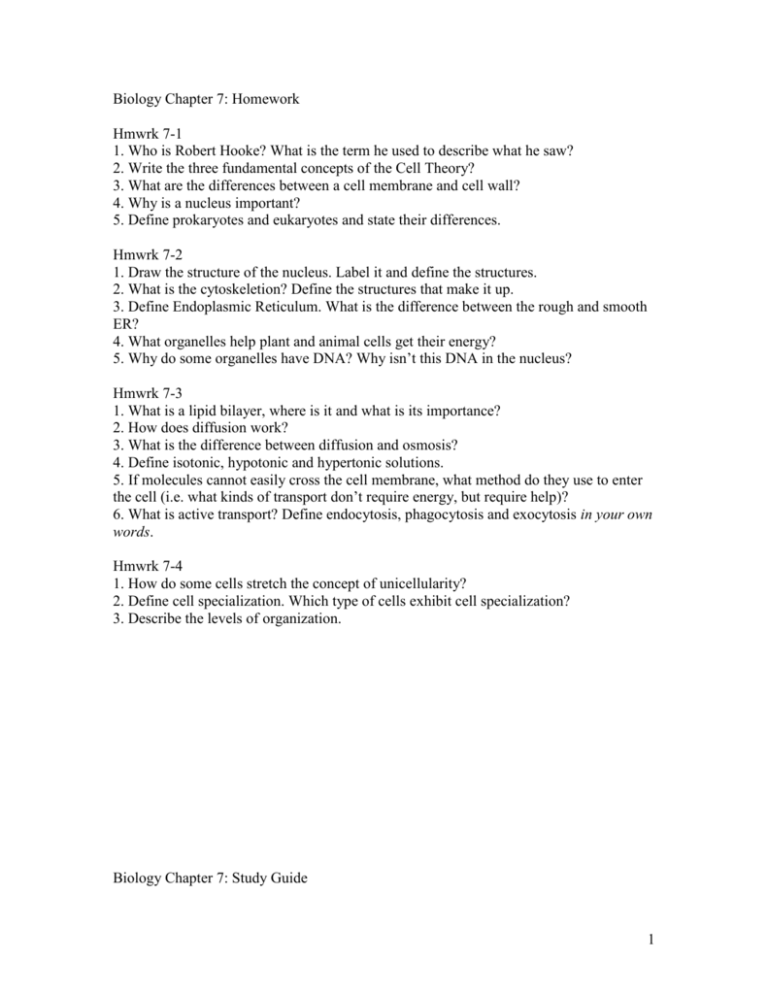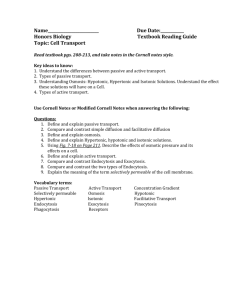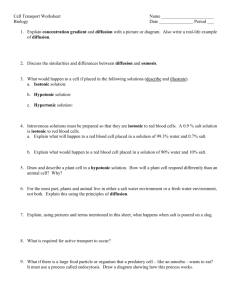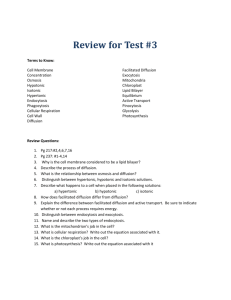Biology Chapter 7: Study Guide
advertisement

Biology Chapter 7: Homework Hmwrk 7-1 1. Who is Robert Hooke? What is the term he used to describe what he saw? 2. Write the three fundamental concepts of the Cell Theory? 3. What are the differences between a cell membrane and cell wall? 4. Why is a nucleus important? 5. Define prokaryotes and eukaryotes and state their differences. Hmwrk 7-2 1. Draw the structure of the nucleus. Label it and define the structures. 2. What is the cytoskeletion? Define the structures that make it up. 3. Define Endoplasmic Reticulum. What is the difference between the rough and smooth ER? 4. What organelles help plant and animal cells get their energy? 5. Why do some organelles have DNA? Why isn’t this DNA in the nucleus? Hmwrk 7-3 1. What is a lipid bilayer, where is it and what is its importance? 2. How does diffusion work? 3. What is the difference between diffusion and osmosis? 4. Define isotonic, hypotonic and hypertonic solutions. 5. If molecules cannot easily cross the cell membrane, what method do they use to enter the cell (i.e. what kinds of transport don’t require energy, but require help)? 6. What is active transport? Define endocytosis, phagocytosis and exocytosis in your own words. Hmwrk 7-4 1. How do some cells stretch the concept of unicellularity? 2. Define cell specialization. Which type of cells exhibit cell specialization? 3. Describe the levels of organization. Biology Chapter 7: Study Guide 1 Section 1 Definitions Cell Nucleus Prokaryote Cell theory Eukaryote Scientists and their work Robert Hooke Matthias Schleiden Rudolf Virchow Anton van Leeuwonhoek Theodor Schwann Know the three fundamental principles of the Cell Theory Differences between eukaryotes and prokaryotes Examples of prokaryotes and eukaryotes Know the two structures that all cells have Section 2 Definitions Organelle Nucleolus Vacuole Cytoplasm Ribosome Mitochondria Nuclear envelope ER Chloroplast Chromatin Golgi apparatus Cytoskeleton Chromosome Lysosome Centriole Be able to label a cell diagram (plant and animal) Know which organelles are in plants and animals Know structure and functions of organelles Know who Lynn Margulis is and what she suggested about organelle DNA Know the components of all organelles Section 3 Definitions Cell membrane Osmosis Endocytosis Cell wall Isotonic Phagocytosis Lipid bilayer Hypertonic Pinocytosis Concentration Hypotonic Exocytosis Diffusion Facilitated diffusion Equilibrium Active transport Be able to label the components of a cell membrane Know what semi-permeable means Be able to determine which solution has a higher concentration Be able to label hypertonic, isotonic, and hypotonic solutions Be able to determine what will happen to a cell in hypertonic, isotonic and hypotonic solutions Be able to determine how equilibrium will be established Know the differences between diffusion, osmosis, facilitated diffusion and active transport Be able to describe the process of exocytosis and endocytosis 2 Section 4 Definitions Cell specialization Organ Tissue Organ system Know the difference between unicellular and multicellular organisms Be able to describe at least one example of cell specialization in animals and plants Know the levels of organization Be able to place examples within the levels 3










